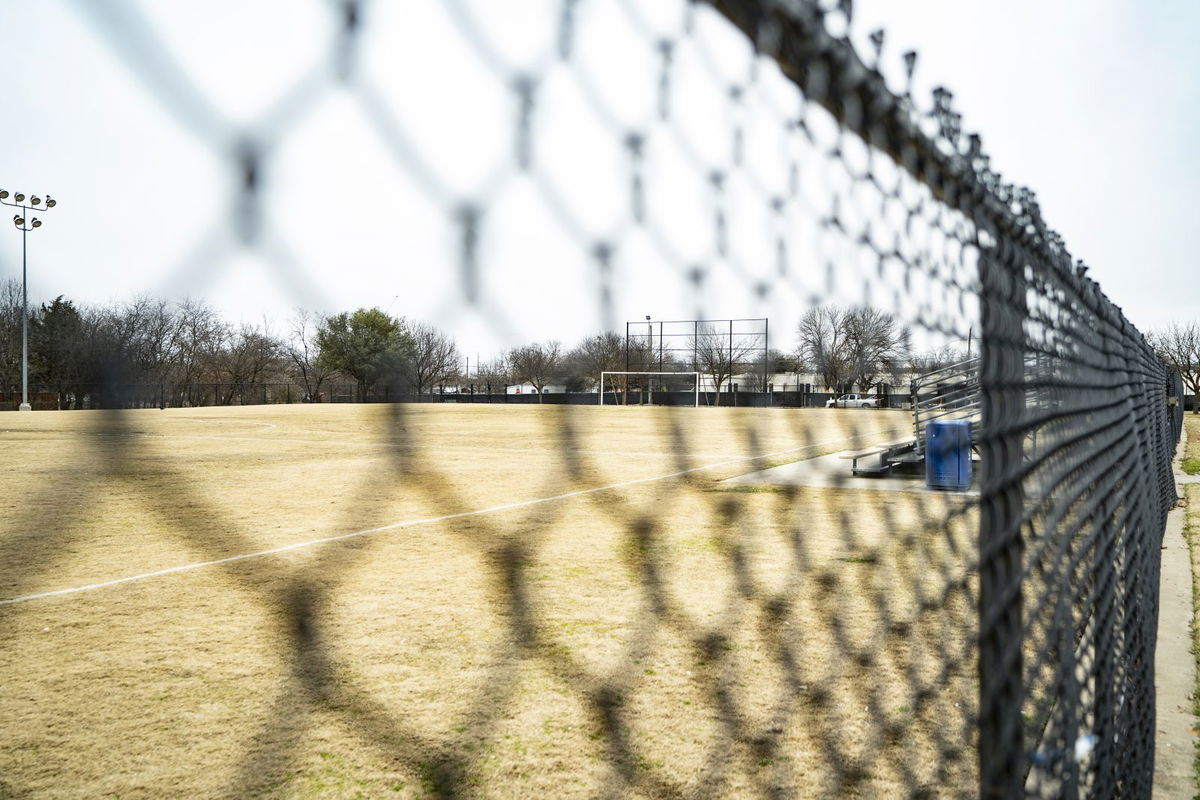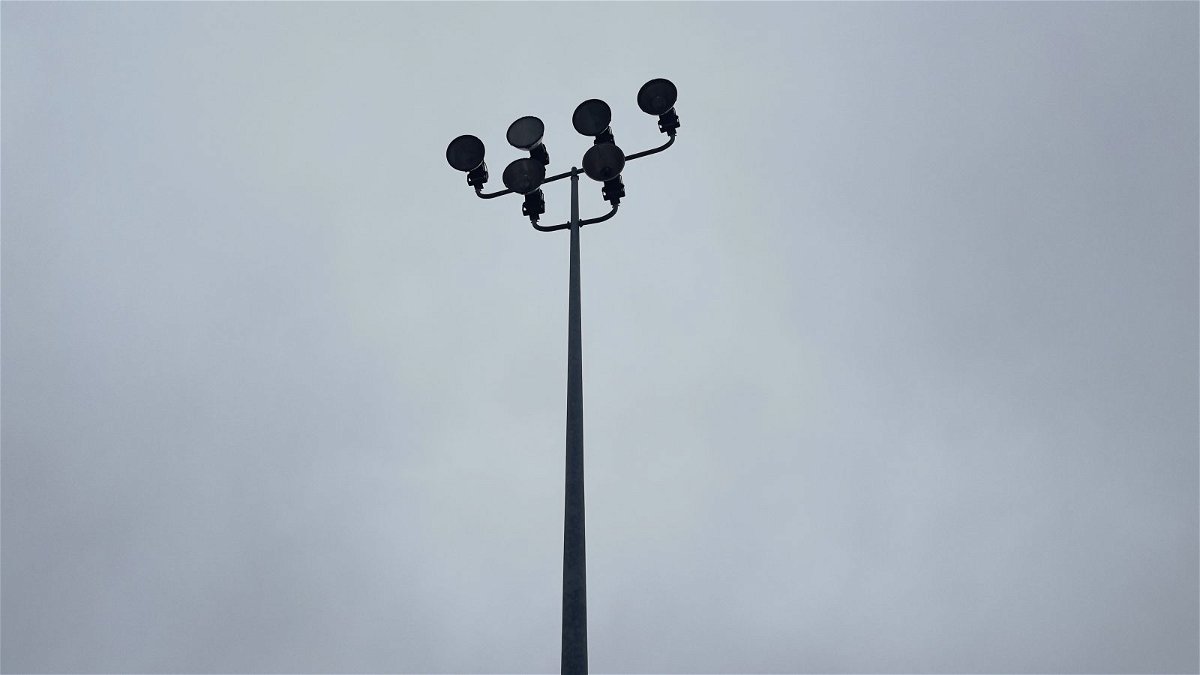On a recent balmy evening, Los Altos neighbors were outside enjoying almost every aspect of West Dallas’ Benito Juarez Parque de Heroes.
A woman walked her dog on the loop trail while a man rode his bicycle. A father and son tossed a football back and forth on the grassy lawn next to the playground, where children climbed under their parents’ watch. Young men shot hoops at the basketball court.
The only exception was the vast soccer field, lush with spring greens but barren of activity. The lock on the fence surrounding the field made sure of that.

The field sits in the middle of the Los Altos neighborhood’s Benito Juarez Parque de Heroes. Years ago, it was a center of neighborhood activity, with pick-up soccer games and parents teaching their young children the sport.
Since 2012, however, when the City of Dallas built a fence around the field, it goes mostly unused, except for the weekends when teams pay the city as much as $61 an hour to use the field for practice or games.
Nearly a decade after the fence went up, residents of the surrounding Los Altos neighborhood say that they are still in the dark on why the city decided to privatize the only public soccer field the neighborhood had for recreation.
Before the fence was built, people played regularly and helped clean the field to preserve the park, says Raul Reyes Jr., vice-president of the Los Altos neighborhood association.
“It’s disappointing seeing that fence and knowing that you have to ask for permission to use it, especially when you see people from other communities come once in a while to use it,” Reyes says.
Is a locked fence an improvement?
Benito Juarez Parque de Heroes has special meaning because of the park’s history in Los Altos. In 1997, a former lot on top of a landfill finally became a park, which the neighborhood had been trying to establish for 17 years, according to an April 5, 1998 Dallas Morning News article.
Once the park began to take shape, organizations and donors began contributing to remodel the park’s facilities. One of them was Samaki Walker, former Dallas Mavericks forward, who contributed $7,000 to construct a basketball court.
“I looked at the landfill — it was pretty rugged and dirty to an extreme,” Walker said in the article. “I wanted to help the kids out. Where I come from, we had to walk four or five neighborhoods until we got the chance to play basketball.”
The same article notes that “volunteers installed playground equipment and built a baseball diamond and soccer field” in 1998. The basketball court Walker funded is still in the park and, though it’s also fenced, it remains available for public use, unlike the soccer field.
“My question is, why not allow that to the soccer part? If you fence in the basketball court, why not allow that same access to the soccer field?” Reyes says.
A year later in 1999, neighbors asked former District 6 Dallas City Councilmember Steve Salazar for a name change that would reflect their Hispanic pride. So the park’s name was changed from Winnetka Park to Benito Juarez Parque de Heroes.
A 17-foot bronze statue of Benito Juarez with a granite base also was erected at the park to commemorate the former Mexican president. Roughly a thousand West Dallas neighbors gathered to celebrate and to enjoy the new park.

With the park established, community members began asking for amenities such as lighting at the park and around the soccer field. In a Dec. 21, 1999 Dallas Morning News article, Salazar confirmed that $200,000 was allotted for park improvements, with funds from both a voter-approved 1998 bond package and federal funds allocated for community development, including an $86,000 price tag for lighting. But the city said “a large demand of construction projects” was delaying the improvements.
Neighbors complained that city officials didn’t care for what the community needed.
“The kids say that they want to play here because it’s their park, but there are no lights,” Isidro Gonzalez said in the article. “Nobody can do anything there after dark. This is a low-income community, and that may be why city officials are not rushing to put the lights up.”
The improvements came a decade later, in 2009. A City of Dallas Park and Recreation Board agenda shows that, initially, the city planned to spend $246,600 in both bond funds and federal funds, but ultimately it spent $449,200 in Community Development Block Grant funds — intended to “build stronger and more resilient communities” — for soccer field improvements, a loop trail, a portable toilet enclosure, site furnishings, two new parking lots — and “fencing.”
“The park’s previous soccer field — which was not fenced in — was highly used and, with so much use, the turf was getting compromised and could not get established,” Andrea Hawkins, who manages visitor experience and community engagement for Dallas parks, told Dallas Free Press via email when we posed questions to the city.
When the field was renovated, Hawkins says, “city and park officials decided to install a fence to protect the recent renovation and to prevent turf damage. The addition of the fence ensured good turf establishment, and the decision to make the field a reservable site helped to control field usage.”
The City of Dallas Park and Recreation Department maintains 91 soccer fields, including 35 lighted fields like the one at Benito de Juarez. Anyone who wants to use fields for practices or games are supposed to reserve them. Rates at Benito de Juarez for adult teams are $26/hour before 7 p.m. and $61/hour after 7. Youth can practice or play for half the price — $13/hour before 7 p.m. and $31/hour after 7 p.m.
Hawkins told us West Dallas neighbors should call to reserve the soccer field if they want to use it.
“There are no plans to remove the fence,” she says.
When Dallas Free Press asked which other soccer fields managed by the City are fenced in, we couldn’t get answers from the city. We also reached out to Park Board Member Tim Dickey, whom West Dallas Councilman Omar Narvaez appointed to make decisions concerning the city’s parks and recreation centers. Dickey did not want to speak publicly about the park or soccer field.
In the past few years, at least two fences at Old East Dallas parks have been removed, one at Crockett Park, a neighborhood park next to Zaragoza Elementary School, and the other at Willis Winters Park next to Woodrow Wilson High School, which includes several athletic fields maintained by the city.
The neighborhood’s voice
Reyes says it is unfair that members of the Los Altos community who pay their taxes don’t have the right to use the Benito de Juarez soccer field.
“Most people used to go up there and run, ride their bikes, I even learned how to drive up there, but we no longer have access to that,” he said. “It’s just the message that the fence gives — ‘You’re not allowed to come here.’ ”
Mirna Mendez from Guatemala, another neighbor who has lived across from the field for five years, says that because the field is closed, they’re forced to find other open fields and recreation spaces far from the neighborhood.
Mendez agrees with Reyes that there is no point of having a soccer field in the neighborhood if it’s not open for public use. Though there is an open space next to the field, it’s not good enough to use, she says. Unlike the soccer field, the open space lacks amenities that the field has.
“As a neighbor of this area, you just can’t walk in there and play,” Reyes says. “If you want to play soccer, you have to play with the trees and that’s not the same experience.”

“It’s a big space but not ideal for our kids to practice sports,” Mendez says. “The conditions are just not the best since it’s next to the street and that can turn out dangerous for our kids if they go chasing a ball.”
For neighbors, having a space where their children can play is essential. Throughout the years, the community has felt as if their needs have not been taken into consideration, and the fenced-in soccer field is a prime example.
“I think places like Anita Martinez Recreation Center or Wesley Rankin Community Center are organizations that could speak for us to try and persuade city officials to open the field again for the neighborhood,” Mendez says.
Impact to the community
Adjacent to Benito Juarez Parque de Heroes is Wesley Rankin Community Center’s Sarah Wilke Youth Center. The center hosts programs for neighborhood children and has seen their outdoor activities cut short because of the closed soccer field.
“We’ve got our summer camps that have up to 200 kids, and that’s the kind of space where they should be able to hang out and have freedom,” says Shellie Ross, executive director of Wesley Rankin Community Center. “We’ve tried adapting and doing other types of outdoor activities like lacrosse, but it just doesn’t feel the same as playing soccer as a community again.”
Ross tried to reach a deal with the city to open the field at least for some of the outdoor activities for Wesley Rankin’s camps in 2012, right after the park was fenced in, but city officials didn’t respond in time, she says.
“Over the years we’ve had to change our curriculum a bit because we don’t have access to the field, especially with hyperactive kids, since asking them to run around the fence is less engaging than taking the soccer ball onto the field,” Ross says.
Part of Wesley Rankin’s initiatives to run these camps and involve children in outdoor activities is to keep them busy and out of potential trouble.
“There are few other community ways or spaces to spend our time in healthy ways,” Ross says. “I think having community spaces in neighborhoods causes people to gather in more positive ways.”
Ross believes making the soccer field open to the community would benefit not only children but their family members, too.
“If the field was open, we’d love to see our kids play, and us moms could also benefit by walking inside the field but unfortunately that’s something that we can’t do,” Mendez says.
As a result, Los Altos neighbors have been forced to look for other soccer fields and spaces to play that are either on the other side of the neighborhood — such as Jaycee Zaragoza Park and Recreation Center in Ledbetter and Bickers Park — or fenced and used only through reservation, such as the fields at the Mercy Street Sports Complex.
The neighborhood is clear that they want their field back.
“I think at this point, what we need to do is kind of revisit that question with the rest of the neighbors of, how can this field be more accessible?” Reyes says. “Then we can push that message on to our councilman or to the parks and rec department.”

Leave a Reply